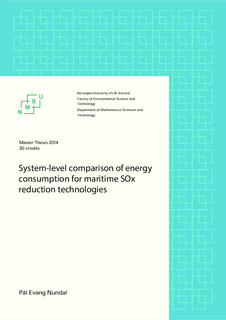| dc.description.abstract | Increasingly stringent regulations of emissions from the marine sector is coming into effect. Amongst other, a limit for SOx content in marine fuels will soon come into effect in large parts of Europe and North America, referred to as Emission Control Areas (ECA).[1] This thesis aim to analyze and compare the energy consumption from three of the most common options to reduce SOx emissions to a compliant level. These are; Switching to a gas engine and use Liquefied Natural Gas (LNG) as fuel, installing a SOx scrubber and continue using heavy fuel oil (HFO) as the main fuel, or switching from HFO to a low sulfur diesel while being inside an ECA. HFO which are the most common used fuel today, are also included to have a known reference to compare with. These technologies are quite new (the LNG engines revived are not yet installed on an operating vessel) so the access to literature is somewhat limited. A large part of the material used is found in articles, some is found in projects done by DNV GL, and some from manufacturer websites. However, the components consuming most of the energy is pumps and heat exchangers, subjects that are curriculum for process engineers. The data material needed to perform the analysis is somewhat limited. This is because manufactures do not supply very detailed information in their brochures, a large part is confidential, and as earlier mentioned the technologies are quite new and have not been researched a lot. A large proportion of the data is taken from internal projects done at DNV GL. Some from open literature. Where reliable data required is not found, there were done assumptions. The results of this thesis summarized: Two-stroke low pressure LNG has an energy consumption of 0,03 % of installed engine power. The required heat transfer to vaporize and heat the fuel is 264,7 kW. Two-stroke high pressure LNG has an energy consumption of 0,32 % of installed engine power. The required heat transfer to the fuel is 180,9 kW. The open and closed loop scrubbers had an energy consumption of respectively 1,9-2,2 % and 0,9-1,1 % of the engine power scrubber. This is in addition to the consumption from the HFO system. The energy consumption for MGO and HFO varies from 0,7-1,5 %. It is assumed that the real number is higher for HFO since several components were excluded, and because it high viscosity will give a higher pressure loss in pipes and components. | nb_NO |
